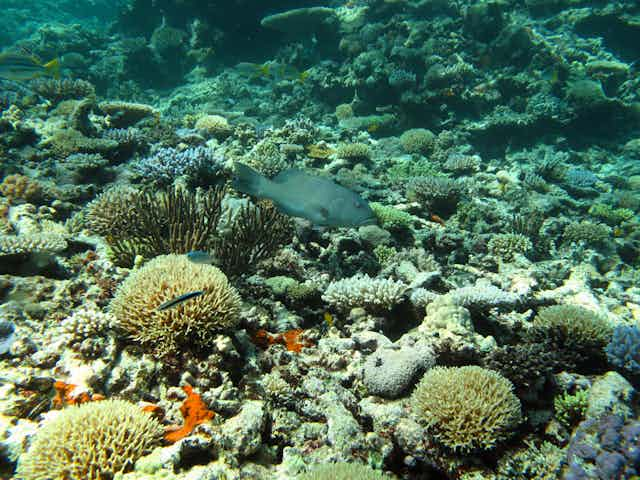Fishing is a major threat to the future health of the Great Barrier Reef, with many species of fish and other wildlife suffering substantial depletion.
One solution is closing parts of the marine park to fishing: so-called “no take zones”. But there’s debate around whether these really work.
However research published today in Current Biology suggests these areas, implemented just over a decade ago, really do help to conserve fish species.
The fishing threat
Perhaps one of the most dearly-held entitlements in countries that border the ocean is for everyone to have free access to fishing. We become aware of this pursuit at a very young age, and fishing represents a cultural as well as economic endeavour in most of these countries, including Australia, where an extensive recreational, indigenous and commercial fishery exists.
Along the Great Barrier Reef fisheries have existed from time immemorial, from aboriginal subsistence all the way to European colonisation and beyond.
Today, both recreational and commercial fisheries are widespread on the Great Barrier Reef. But the Great Barrier Reef Marine Park Authority (GBRMPA) has identified fishing as a primary threat to the reef’s future health.
The Great Barrier Reef Marine Park was established in 1975 with the Great Barrier Reef Marine Park Act and a mandate to protect and conserve the heritage values of the Great Barrier Reef, through the Marine Park Authority.
Healthy stocks in many reef fisheries have suffered overfishing, with bech-de-mere (sea cucumber), pearl oyster, dugong and turtle fisheries having collapsed in the 20th century. Nonetheless, for more than 25 years, fishing pressure was not a central feature of the authority’s management, so these fisheries remain depleted today, along with Spanish mackerel , sharks, and snapper (Pagrus auratus).
Despite the Trawl Management Plan of 2000, the Marine Park Authority has warned that many species remain at risk from trawling, including sea snakes, skates and rays, and lobster.
Closing the reef to fishing
The Great Barrier Reef Zoning Plan 2003, implemented in 2004, was a dramatic shift in approach to managing the reef. This recognised that “no take” areas closed to any extractive activities, including fishing, were key to protecting the reef.
Under the zoning plan these no-take areas were increased from around 5% to 33% of the marine park.
There is a growing body of evidence that the long-term and recent declines in fish are being effectively mitigated through the sharp rise in no-take areas and other changes that came into effect in 2004.
For instance, numbers of white-tip and grey reef sharks have seen large increases within no take areas compared to those where fishing is allowed.
There’s also evidence that no-take zones have helped replenish the reef, in both fished and no take zones, with coral trout and stripey snapper, an effect known as “spill-over”.
The paper released today led by Michael Emslie of the Australian Institute of Marine Science finds that there are more, and bigger coral trout in no take areas of the Great Barrier Reef.
This research is particularly instructive because it illustrates the effects of the no take areas on coral trout, a species targeted by both commercial and recreational fishers.
The study used underwater survey data gathered between 1983 and 2012, finding that the density, length and biomass (the total mass of all the fish) of coral trout were substantially greater in no-take areas than on fished reefs. Moreover, coral trout biomass declined only on fished reefs after severe Tropical Cyclone Hamish in 2009.
From these data, the authors concluded that the measures put in place in 2004 have had a positive and long-lasting effect on both coral trout abundance and their resilience to disturbance on the Great Barrier Reef. Such a conclusion is consistent with a large body of studies from both the reef and in other tropical and even temperate locations around the world.
Do no take zones work?
In contrast to the conclusions of the new study, another very recent study claimed that the 2004 rezoning of 33% no-take areas resulted in a 35% decline in total annual catch and a 36% decline in fishery value. The authors of the study called into question the government’s commitment to insuring minimal damage to the commercial fishing industry from the 2004 rezoning.
However, a number of other changes were happening at the same time, including buy out of fishery licenses, and introduction or reduction of total allowable catch limits and quotas, so that evaluating catch and value of Great Barrier fisheries solely on the basis of the 2004 rezoning remains unsubstantiated.
The analysis also seems to suffer from comparing apples to oranges – the control sites used were further north and further south of the marine park and encompassed many different suites of wildlife. Moreover, the new coral trout study points out that marine protected areas are at best a coarse tool, and not specifically designed for fisheries management.
So what do we gain from knowledge about increases in both fish numbers and resistance to disturbance in no take areas of the Great Barrier Reef?
We learn to, at least, stay the course – maintain the network of no-take areas in the Great Barrier Reef Marine Park. As fish biomass increases so too does population size, leading to replenishment of populations adjacent to the no take areas - a “spill-over” effect to fished areas – aiding commercial and recreational fisheries.
Maintaining our networks of no take areas on the reef also provides proven resilience to the Great Barrier Reef World Heritage Area, which has come under increasing pressure from declining water quality and will almost certainly face critical challenges as climate change intensifies.
No take areas protect Great Barrier Reef fish, enhance their productivity, and provide insurance against catastrophic loss from ongoing and future disturbance.

